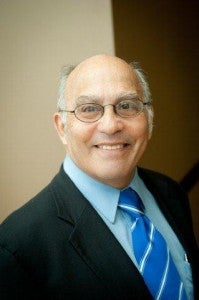“With great pleasure and pride I announce that our own Alan D. Rogol, MD PhD has been awarded the prestigious Judson J. Van Wyk Prize for lifelong achievement by the Pediatric Endocrine Society for 2015! This is the Society’s most prestigious award, recognizing ‘an outstanding leader who has displayed a career of scientific excellence, leadership and dedication to the health of children.’ Dr. Rogol has been a source of pride to our Department, Children’s Hospital and School of Medicine for a long time. I am very proud to have him among us,’ said Dr. Jim Nataro.
Here’s what Dr. Rogol had to say about the award:
Q: Congratulations! What does this award means to you?
A: This is the crown jewel in my professional life. As stated below, the benchmarks for choosing the incumbent are strict. Perhaps more importantly, it is the recognition by my peers that is so rewarding
Q: PES says this award goes to someone who has “displayed a career of scientific excellence.” Please tell me what significant moment (or moments) stands out in your career.
A: The answer is narrowed to my academic career. One of the major joys of this academic life is the wonderful folks with whom I collaborate. Over the years, there have been several new diseases/conditions and I feel privileged to have been involved with these developments. Here are a few examples with references:
- In 1976, I was involved with the first description of a very strange collection of pituitary deficiencies, which was published as just that. Fifteen years later, a colleague noted the paper and that the new molecular biology might have an answer. Sure enough, it did and the molecular basis of this man’s disease was discovered.
- Rogol AD, Kahn CR: Congenital hypothyroidism in a young man with GH, thyrotropin and prolactin deficiencies. J Pediatr,88:953 958, June, 1976.
- In 1982, I worked with a patient with Turner syndrome from my colleague Dr. Ann Johanson’s clinic. The patient was very tall for her condition. With the major collaboration of colleagues in internal medicine (Michael Thorner was the leader), it became clear that she had an odd form of too much growth hormone (acromegaly). Because of Dr. Thorner’s reasoning about the histology of the pituitary gland and the lack of cure using a standard operation on the pituitary, a search for an unknown stimulating hormone was undertaken. A pancreatic tumor was noted and as soon as it was removed the levels of growth hormone diminished. Blood samples were taken at very short intervals during the operation and it was in my lab that the measurements were made. The most exciting moment was watching the counts of radioactivity (the assay for growth hormone involved radioactivity) indicating lower and lower levels of growth hormone with a time course compatible with the disappearance of growth hormone. This meant no ongoing secretion – and a cure. Dr. Thorner and several of us in pediatrics designed a clinical trial of this substance to test whether it could be used as a drug in children with growth hormone deficiency. It clearly did and the rest is history.
- Thorner MO, Perryman RL, Cronin MJ, Rogol AD, Draznin M, Johanson A, Vale W, Horvath E, Kovacs K: Somatotroph hyperplasia: Successful treatment of acromegaly by removal of a pancreatic tumor secreting a GH releasing factor. J Clini Invest, 70:965 977, Nov, 1982.
- In 1995, a patient of mine had an unreported cause for adrenal failure. The testes as well as the adrenal glands made steroid hormones and it was from the former that our patient was one of the first (along with others in this report) to have steroid acute regulatory hormone deficiency.
- Lin D, Sugawara T, Strauss III JR, Clark BJ, Stocco DM, Saenger P, Rogol A, Miller WL. Role of steroidogenic acute regulatory protein in adrenal and gonadal steroidogenesis. Science, 267:1828-1831, March, 1995.3.
- In 2002, one of my patients had an adrenalectomy for congenital virilizing adrenal hyperplasia. (This is a very rare occurrence, for we are usually able to use medication alone.) The pathophysiology of the defect between the two parts of the adrenal was discovered. This time, the discovery came from outside of UVA, but was because of the collaboration with other experts.
- Merke DP, Chrousos GP, Eisenhofer G, Keil MF. Rogol AD, van Wyk JJ, Bornstein SR. Adrenomedullary dysplasia in patients with classic 21-hydroxylase deficiency. N Engl J Med, 343:1362-1368, November 6, 2000.
Q: You’ve been with UVA for 40 years (24 fulltime, professor of pediatrics and chief of the division of endocrinology and professor of pharmacology). What is the best part of working at the University?
A: This one is easy! My mentors, collaborators, and colleagues. Our first chair was Robert M. Blizzard who had the foresight to recruit (very) young pediatricians and let us do our “stuff”. A group of seven of us who were recruits of Dr. Blizzard have more than 240 years of service at UVA, a statistic unheard of in the highly mobile world of academics.
Q: This award represents “lifelong achievement.” What are your goals for the years to come?
A: To teach, to write, to travel and be physically fit.
Filed Under: Features

